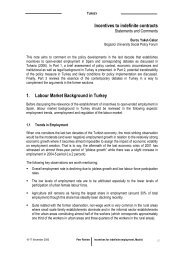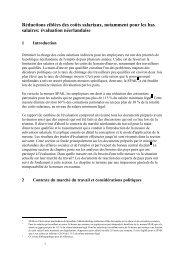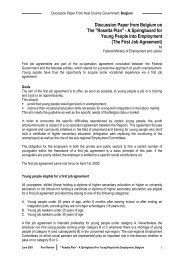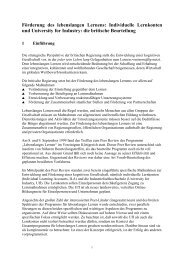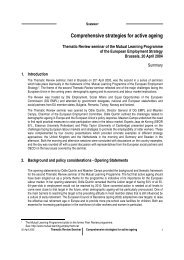Reform of Severance Pay Law in Austria - mutual learning programme
Reform of Severance Pay Law in Austria - mutual learning programme
Reform of Severance Pay Law in Austria - mutual learning programme
You also want an ePaper? Increase the reach of your titles
YUMPU automatically turns print PDFs into web optimized ePapers that Google loves.
DISCUSSION PAPER<br />
Figure 5: Asset Allocation <strong>of</strong> MVK’s<br />
Asset Allocation<br />
6.06<br />
3.73 1.69<br />
7.5<br />
Bonds/EUR<br />
Real estate<br />
Equities/EUR<br />
Bonds/Non-EUR<br />
Equities/Non-EUR<br />
81.02<br />
Source: Österreichische Kontrollbank<br />
3.3 <strong>Severance</strong> pay and occupational pensions<br />
In the coalition program 2000 the federal government stated their <strong>in</strong>tension to develop a three<br />
pillars pension system <strong>in</strong> <strong>Austria</strong>. The government announced to transform the system <strong>of</strong><br />
mandatory severance payments <strong>in</strong>to a new l<strong>in</strong>ear payment system scheme, which should act as<br />
funded pillar <strong>of</strong> the pension scheme. Orig<strong>in</strong>ally, the government did not wish to provide for the<br />
possibility <strong>of</strong> pay<strong>in</strong>g severance pay directly to employees on the term<strong>in</strong>ation <strong>of</strong> their employment<br />
relationship, but favoured a model <strong>in</strong> which severance pay entitlement went purely to fund<br />
occupational pensions. However, the <strong>Austria</strong>n Trade Union Federation <strong>in</strong>sisted on a choice for<br />
employees <strong>in</strong> the use <strong>of</strong> their severance pay entitlement, argu<strong>in</strong>g that a compulsory occupational<br />
pension scheme (based on <strong>in</strong>vestments <strong>in</strong> the private capital market) would be a first step<br />
towards underm<strong>in</strong><strong>in</strong>g the more secure statutory pension system (see EIRO 2001). In the end, the<br />
social partners and the government agreed on a compromise where severance pay paid directly<br />
to employees on term<strong>in</strong>ation <strong>of</strong> their employment will be taxed at a flat rate <strong>of</strong> 6%, whereas<br />
severance payments saved towards a private pension will be tax-free.<br />
It was an explicit hope <strong>of</strong> the government that the severance payments reform would also<br />
contribute to the expansion <strong>of</strong> the underdeveloped second pension pillar <strong>in</strong> <strong>Austria</strong>. Koman et al.<br />
(2005) simulated a multi-pillar pension reform for <strong>Austria</strong>, us<strong>in</strong>g the World Bank’s Pension <strong>Reform</strong><br />
Options Simulation Toolkit. Their reform scenario <strong>in</strong>volves the move from the current notional<br />
def<strong>in</strong>ed benefit pension scheme to a notional def<strong>in</strong>ed contribution (NDC) scheme at the beg<strong>in</strong>n<strong>in</strong>g<br />
<strong>of</strong> 2005, with a complete switch <strong>of</strong> all active contributors, a full recognition <strong>of</strong> accrued rights and a<br />
full protection <strong>of</strong> pensions already <strong>in</strong> payment, and the <strong>in</strong>troduction <strong>of</strong> a second, mandated fully<br />
funded pillar, evaluated under two policy scenarios with contribution rates to the funded pillar <strong>of</strong> 5<br />
percent and 10 percent, respectively.<br />
30 Nov - 1 Dec 2006 Peer Review <strong>Reform</strong> <strong>of</strong> <strong>Severance</strong> <strong>Pay</strong> <strong>Law</strong>, Vienna<br />
16



